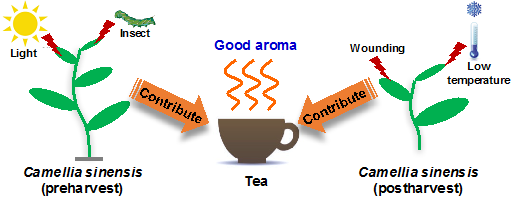Recently, tea research group of the South China Botanical Garden, Chinese Academy of Sciences (PI: Prof. Ziyin Yang) published a review entitled “Understanding the biosyntheses and stress response mechanisms of aroma compounds in tea (Camellia sinensis) to safely and effectively improve tea aroma” in Critical Reviews in Food Science and Nutrition (The first author: Dr. Lanting Zeng).
Metabolite formation is a biochemical and physiological feature of plants developed as an environmental response during the evolutionary process. These metabolites help defend plants against environmental stresses, but are also important quality components in crops. Utilizing the stress response to improve natural quality components in plants has attracted increasing research interest. Tea, which is processed by the tender shoots or leaves of tea plant (Camellia sinensis (L.) O. Kuntze), is the second most popular beverage worldwide after water. Aroma is an important factor affecting tea character and quality. The defense responses of tea leaves against various stresses during preharvest (tea growth process) and postharvest (tea manufacturing) processing can result in aroma formation. Herein, we summarize recent investigations into the biosyntheses of several characteristic aroma compounds prevalent in teas and derived from volatile fatty acid derivatives, terpenes, and phenylpropanoids/benzenoids. Several key aroma synthetic genes from tea leaves have been isolated, cloned, sequenced, and functionally characterized. Biotic stress (such as tea green leafhopper attack) and abiotic stress (such as light, temperature, and wounding) could enhance the expression of aroma synthetic genes, resulting in the abundant accumulation of characteristic aroma compounds in tea leaves (Figure 1). Understanding the specific relationships between characteristic aroma compounds and stresses is key to improving tea quality safely and effectively.

Figure 1 Effects of different stresses on tea aroma formation at the preharvest and postharvest stages
The review paper is shown below. https://www.tandfonline.com/doi/abs/10.1080/10408398.2018.1506907?journalCode=bfsn20
